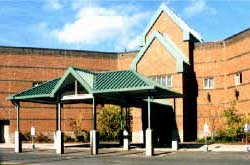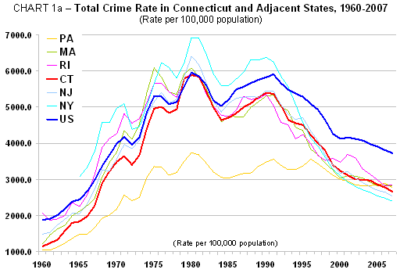
Criminal Justice in Connecticut
The State of Connecticut manages most of the criminal justice institutions located in the state. The following sections briefly summarize key data points and statistical information about the state’s crime rates, prisons, and criminal rehabilitation programs, highlighting what works and what could be improved.
Connecticut Prison Population Stats
How many people are incarcerated in Connecticut? What are Connecticut’s biggest prisons? Answering these questions is an efficient way to understand the prison scope in this small northeastern state. To start, Connecticut ranks 38th in the nation for its prison population per capita, ahead of Alaska but behind Washington State.1
According to the National Institute of Corrections, most of those incarcerated in Connecticut are in state jails (usually serving short-term sentences or awaiting trial) or in state prisons (usually serving full-length prison sentences). Unlike most states, Connecticut utilizes a unified system, which means its state-level jails and prisons are combined into the same facilities. Connecticut incarcerates about 8,751 people in its prisons and about 13,106 in its jails. The inmates are spread across 14 state facilities that function as jails and prisons. Connecticut does not utilize private prisons or outsource its prisoners to other states. Two federal prisons operate in Connecticut, housing some 862 inmates.2

As of 2019, the Connecticut community corrections population had 46,475 individuals under probation and 3,651 under parole. The state’s Department of Corrections budget is about $650,000,000 yearly, making it the seventh largest item in the state’s annual budget.3
The MacDougall-Walker Correctional Institution is the largest prison in Connecticut, located in Suffield. Housing some 2,049 inmates, it is also the largest correctional facility in the New England region.4
Connecticut Crime and Recidivism

Connecticut reports about 184 violent crimes yearly for every 100,000 people living in the state and about 1,427 property crimes for every 100,000. These figures suggest Connecticut has a slightly lower crime rate than the average crime rate of other northeastern states. Connecticut also has a slightly lower crime rate than the United States average. When all forms of crime are considered, Connecticut currently reports about 2,655 crimes per 100,000 population, the lowest the state’s crime rate has been in almost 40 years.5
The Bureau of Justice Assistance reports that Connecticut has a recidivism rate of 54.3%. Unfortunately, that means the state’s criminal justice system is not working for more than half of those who go through it.6 It’s worth mentioning, however, that even though more than half of formerly incarcerated persons in Connecticut wind up back behind bars, the state has a lower recidivism rate than the national average. About two out of three offenders in the United States are rearrested within three years of release. More than half are incarcerated again.7
It’s a good sign that Connecticut’s crime rates have declined gradually for four decades. However, a high recidivism rate indicates partially ineffective criminal reform programs. There is a need for evidence-based rehabilitation programs in Connecticut. Such programs would reduce the toll of incarceration on the state’s budget (which again is the state’s seventh costliest budget item). Better programs would also improve public safety, reduce recidivism, free up funds for other social programs, and improve Connecticut residents’ overall quality of life.
Criminal Reform in Connecticut
Connecticut has implemented some programs within its criminal justice system that have proven quite effective. For example, the Charlene Perkins Reentry Center is a 100-bed stand-alone program on the grounds of the York Correctional Institutional Center in Niantic. It has proven quite successful in rehabilitating women offenders. Of those who complete this program, only 16% return to prison, a much lower recidivism rate than the state’s average.8
Similarly, the Administrative Segregation Program at the Northern Correctional Institution is another program that has proven successful in helping inmates. This program is reserved for those who engage in aggressive, violent, or disruptive behavior. Between 2006 and 2007, about 120 offenders took part in this program, which requires a ten-month stay. Of the total number of inmates who completed the program, only nine were returned to the program over two years, with a low recidivism rate of just 7.55%.
Alternatives to Incarceration
There is a need for alternatives to prison in Connecticut, programs that can help improve people’s lives and steer them away from making poor choices without having to incarcerate them.

On a policy level and regarding recidivism, Connecticut still follows a rather outdated policy in which it locks up individuals for technical violations of probation and parole (which are not crimes and which do not require reintroduction of the individual into the prison system). According to the state’s data reports, 50% of those re-incarcerated in Connecticut are individuals serving new sentences simply for violating the terms of their probation, even if that violation was just a technical violation or a minor error on the offender’s part (not a crime). If Connecticut disbanded its procedure of re-incarcerating individuals for technical violations, it would reduce recidivism significantly (potentially by up to 50%) and keep formerly incarcerated individuals out of prison.
The report cited in the above paragraph also revealed hopeful information about Connecticut’s implementation of rehabilitation programs inside prisons for drug and alcohol abuse. According to the data, inmates who sought substance abuse treatment were significantly less likely to be rearrested following their release. Only about 32% of such individuals were rearrested Save within one year of release, compared to about half of those who did not complete a substance abuse program.
One could suggest that Connecticut take its in-jail and in-prison substance abuse treatment programs further. Rather than only putting incarcerated inmates through a drug rehab program, Connecticut could also direct non-violent drug offenders through drug rehab programs without incarcerating them. Connecticut has already implemented some programs like this through its Drug Courts system. However, there are only two drug courts in the entire state of Connecticut, one in Danielson and one in New Haven. Such programs are immensely overburdened.9
Connecticut would do well to follow the criminal reform model of other states like Washington, Massachusetts, and New Jersey. These states have implemented diversion programs where non-violent offenders arrested for behavioral crimes like drug abuse or prostitution are directed into residential treatment centers instead of prison cells. King County’s LEAD Program (Law Enforcement Assisted Diversion) is a good example of a diversion program that would likely do well in Connecticut.10
There is also a need for both educational programs inside prisons in Connecticut and evidence-based rehabilitation programs inside prisons in Connecticut.
The criminal justice system in Connecticut has gotten some things right. But there is always room for improvement. Criminal rehabilitation in Connecticut would be greatly improved if the state brought more education-based programs into the prisons. These programs could empower inmates to make better decisions and life choices when they get out of prison.
Sources:
- BJS. “Prisoners in 2020 – Statistical Tables.” Bureau of Justice Statistics, 2020. bjs.ojp.gov
- NIC “Connecticut 2019.” National Institute of Corrections, 2019. nicic.gov
- Urban. “Project Connecticut.” Urban Institute, 2022. urban.org
- Connecticut State. “MacDougall-Walker Correctional Institution.” Connecticut Department of Correction, 2022. portal.ct.gov
- Connecticut State. “Crime Trend Reports.” Office of Policy and Management, 2022. portal.ct.gov
- BJS. “State Criminal Justice Profile, Connecticut.” Bureau of Justice Assistance, 2014. bjafactsheets.iir.com
- ODPHP. “Incarceration.” Office of Disease Prevention and Health Promotion, 2020. healthypeople.gov
- Connecticut State. “Recidivism.” Department of Correction, 2022. portal.ct.gov
- OLR. “Connecticut’s Drug Courts.” OLR Research Report, 2015. cga.ct.gov
- LEAD. “Law Enforcement Assisted Diversion.” LEAD, 2022. leadkingcounty.org
Related Articles
Criminal Justice Reform Extends Rights to Felons Who Have Served Their Sentences
For decades, voter enfranchisement or disenfranchisement for incarcerated and formerly incarcerated individuals has been debated. An estimated 4.6 million Americans are barred from voting due...
Read more >>
Nine States Have Reduced Their Prisoner Population by 30%. What Do They Have in Common?
For the first time in decades, several U.S. states are making a concerted effort to reduce their prison populations by applying a range of policy...
Read more >>
This Program Saved My Life
Overcoming Addiction Course I have been enlightened in the Overcoming Addiction Course it says we are in a chemically oriented society. I said to myself,...
Read more >>
The Way to Happiness Criminon Connecticut
It may sound cliche, but taking the Way to Happiness Course has changed my life. The wins I have had are to numerous to count,...
Read more >>





